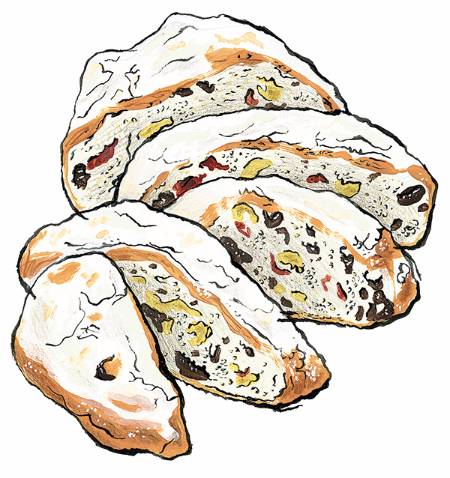In 1329 the Bishop of Naumburg held a Christmas baking contest. Imagine a medieval fair and you’re on the right track. The trick was that the baked goods had to be okay for the Advent, which meant no butter and no sugar. The winner was stollen. It might have looked pretty similar to the cake we know: an oblong, footballish-shaped loaf. But it wouldn’t have tasted anything like modern stollen. The original stollen would have been just flour, water, yeast, and oil. There must have been something special about it, though—the stollen was such a hit that the Bishop ordered that a store of grain be set aside every year for the sole purpose of making stollen.
The 1% of medieval Germany loved stollen. But the popes—not so much.
The German elite have a long history with stollen. It starts with Dresdeners Prince Ernst and his brother Duke Albrecht, who wrote to the Pope in 1450 to see if they could break the Advent rules and include butter in their stollen. No dice. The Pope refused. They were not easily discouraged, though. For the next four decades they kept writing. Each new pope got a butter request and each new pope turned them down. Finally, forty years of letters and five popes later, Pope Innocent VIII gave in. He sent back a scroll called the Butterbrief, an official document that allowed the bakers in Dresden—and only in Dresden—to bake with butter. Of course, the pope took his pound of flesh—he instituted a tax on buttered stollen. After paying it, they could bake with all the butter they wanted “with a clear conscience and God’s blessing.” Amen.
The tax made stollen expensive—a food for the 1% only. Thirty years after the Butterbrief was sent, Saxony went Protestant and the butter ban was lifted. Now everyone was free to bake with all the butter they liked, but stollen remained a food of the elite. In addition to the butter, bakers started adding expensive ingredients like sugar, exotic spices like cardamom, cinnamon, and clove, and candied fruits and citrus peels. With those additions, the stollen we know today was born. Of course, every baker has their own take on it: each one has their own secret blend of spices, and the mix of candied fruits included may vary a bit. But in general, the recipe for stollen has changed very little in the last 500 years.
Stollen’s reputation as a food for royalty was solidified in 1560, when a group of eight master bakers from Dresden got together and made a 36-pound stollen, then had a group of eight journeymen carry it to the King of Saxony as a Christmas gift. It went over so well that they started delivering a huge stollen to the king every year. The tradition continued until 1918, when Emperor Wilhelm II abdicated the throne—and with it, his right to the giant annual Christmas cake. I wonder which one he missed more?
One year a 36-pound stollen wasn’t enough. In 1730, August II the Strong, who was the Elector of Saxony as well as being the King of Poland and Grand Duke of Lithuania, threw a month-long party for 20,000 of his closest friends to prove how strong his military was. For the occasion, he decided to serve a stollen that was 27 feet long, 18 feet wide, a foot tall, and weighed in at over 3,700 pounds! To make it, his court architect designed a special, oversized stollen oven. And to serve it, he had his carpenter craft a special five-foot long stollen knife. The knife was kept in the royal silver chamber of Dresden castle from 1730 until World War II, when it went missing. I’d like to think that since then it’s been in the hands of someone who likes to throw lots of super secret ginormous stollen parties.
Our stollen is made by the master bakers at Zingerman’s Bakehouse.
A big part of what makes it so great is the amount of fruit included in it: glacéed lemons, oranges, Michigan cherries, fresh lemon and orange zest, fresh lemon juice, currants, golden raisins, and Red Flame raisins. All of that fruit soaks in Bacardi rum for at least 24 hours before being mixed into the dough. They use so much rum to make the stollen that they have to place their order for it well in advance to make sure there’s enough—otherwise they’ll end up needing to raid all the local liquor stores. In addition to the fruit, the recipe includes almonds, organic Mexican vanilla beans, and a bit of Indonesian cinnamon sprinkled on top. The whole cake is blanketed in a thick coating of powdered sugar. And of course, there’s plenty of butter. (Thank you, Ernst and Albrecht!)
All the butter and sugar allow the cake to keep for weeks without any added preservatives. One year, Amy Emberling, a woman who’s made thousands of stollens during her tenure as one of the owners of Zingerman’s Bakehouse, sent a stollen to her mother-in-law. “She didn’t think she’d like it, so she avoided it for a couple of weeks. When she finally decided to try it, she couldn’t believe how good it was.” You won’t want to wait that long to find out, trust me.

